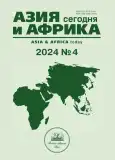Создание и регулирование цифровых платформ в Китае
- Авторы: Запьянцев А.А1
-
Учреждения:
- НИУ ВШЭ
- Выпуск: № 4 (2024)
- Страницы: 54-60
- Раздел: Трибуна соискателя
- URL: https://journals.rcsi.science/0321-5075/article/view/257192
- DOI: https://doi.org/10.31857/S032150750027789-9
- ID: 257192
Цитировать
Полный текст
Аннотация
Ключевые слова
Об авторах
А. А Запьянцев
НИУ ВШЭ
Email: azapyantsev@hse.ru
ORCID iD: 0000-0001-8652-0282
аспирант Москва, Россия
Список литературы
- Моазед А., Джонсон Н. Платформа. Практическое применение революционной бизнес-модели. М.: Альпина Паблишер, 2019. Moazed A., Johnson N. 2019. Platform. Practical application of the revolutionary business model. Moscow. (In Russ.)
- Срничек Н. Капитализм платформ. М.: Изд. дом Высшей школы экономики. 2019. Srnichek N. 2019. Platform capitalism. Moscow. (In Russ.)
- Bloomberg News. 2021. ‘China’s Didi crackdown is all about controlling data’. https://bloomberg.com/news/features/2021-07-08/-didi-crackdown-big-data-is-the-latest-u-s-china-battleground?sref=aK56ygxJ (accessed 17.05.2023)
- Bovingdon G. 2019. Xinjiang. In: W.A.Joseph (Ed.), Politics in China (3rd ed., pp. 487–516). Oxford University Press
- Breznitz D. & Murphee M. 2011. Run of the Red Queen: Government, Innovation, Globalization and Economic Growth in China. Yale University Press.
- Cai C., & Wang T. 2022. Moving toward a “middle ground”? The governance of platforms in the United States and China. Policy & Internet, May. doi: 10.1002/poi3.303
- Child J. & Rodrigues S.B. 2005. The internationalization of Chinese firms: A case for theoretical extension? Management and Organization Review, 1(3), pp. 381–410.
- Greeven M.J., & Wei W. 2018. Business ecosystems in China: Alibaba and competing Baidu, Tencent, Xiaomi and LeEco. Routledge (accessed 25.06.2023)
- He Q. 2022. Rethinking the legal regulation of Internet platform monopoly in China. Policy & Internet, 14(2),pp. 284–303.
- Hermes S., Clemons E., Schreieck M., & Pfab S. 2020. Breeding grounds of digital platforms: Exploring the sources of American platform domination, China’s platform self‐sufficiency, and Europe’s platform gap. Paper presented at the 28th European Conference on Information Systems. https://www.researchgate.net/publication/341219517_Breeding_Grounds_of_Digital_Platforms_Exploring_the_Sources_of_American_Platform_Domination_China%27s_Platform_Self-Sufficiency_and_Europe%27s_Platform_Gap/ (accessed 05.02.2023)
- Hille K. 2012. Sina Weibo still has to turn users into revenue. Financial Times. February 12. https://www.ftchinese.com/story/001043116/en?archive/ (accessed 14.07.2023)
- Huang L. & Huang H. 2022. 稳字当头, 两年连提“反垄断”! 政府工作报告释放哪些信号? [Make ensuring stability a top priority, mention “anti‐monopoly” two years in a row! What are the signals of the government work report?]. Southern Metropolis Daily. https://www.toutiao.com/i7071529812157792805?wid=1647826185820 (accessed 19.08.2023)
- Huang X., Kenney M. & Patton D. 2015. Responding to uncertainty: Syndication partner choice by foreign venture capital firms in China. Venture Capital, 17(3), pp. 215–235.
- Kenney M. & Zysman J. 2016. The rise of the platform economy. Issues in Science and Technology, 32(3), pp. 61–69.
- King G., Pan J. & Roberts M.E. 2013. How censorship in China allows government criticism but silences collective expression. American Political Science Review, 107(2), pp. 326–343.
- Kroeber A. 2020. China’s economy: What everyone needs to know. Oxford University Press.
- L.Y., Luo J., Zheng L. & Zhang D. Ant and China banks are reining in joint loans to consumers. Bloomberg News. 2021, February 3. https://www.bloomberg.com/news/articles/2021-02-04/antand-chinese-banks-are-reining-in-joint-loans-to-consumers/ (accessed 23.07.2023)
- Liu C. 2010. Internet censorship as a trade barrier: A look at the WTO consistency of the Great Firewall in the wake of the China‐Google dispute. Georgetown Journal of International Law, 42, pp. 1199–1240.
- Lucas L. 2017. Chinese money market fund becomes the world’s biggest. Financial Times. April 26. https://www.ft.com/content/28d4e100-2a6d-11e7-bc4b-5528796fe35c/ (accessed 12.09.2023)
- McKnight S., Kenney M. & Breznitz D. 2023. Regulating the platform giants: Building and governing China’s online economy. Policy & Internet, 15, pp. 243–265. https://doi.org/10.1002/poi3.336 (accessed 24.02.2023)
- Mueller M.L. & Farhat K. 2022. Regulation of platform market access by the United States and China: Neomercantilism in digital services. Policy & Internet, 14(2), pp. 348–367.
- Roberts M.E. 2018. Censored: Distraction and diversion inside China’s Great Firewall. Princeton University Press.
- Schwab K. The Fourth Industrial Revolution. World Economic Forum. January 11, 2016, ISBN 1944835008
- Stiglitz J. Monopoly’s New Era. Project Syndicate. 2006. May 13. https://www.project-syndicate.org/commentary/high-monopoly-profits-persist-in-markets-by-joseph-e--stiglitz-2016-05 (accessed 30.01.2022)
- Tse E. 2015. China’s disruptors: How Alibaba, Xiaomi, Tencent, and other companies are changing the rules of business. Portfolio/Penguin (accessed 19.07.2023)
- Yang G. 2019. Policy Case Study: Internet Politics. In: W.A.Joseph, (Ed.), Politics in China (3rd ed.). Pp. 440–454. Oxford University Press.
- Yang Y. 2019. Policy articulation and paradigm transformation: The bureaucratic origin of China’s industrial policy.Review of International Political Economy, 28(1), Pp. 1–28.
- Yu H. 2017. Networking China: The digital transformation of the Chinese Economy. University of Illinois Press.
- Zhang A.H. 2021. Chinese Antitrust Exceptionalism: How the rise of China challenges global regulation. Oxford University Press.
Дополнительные файлы











